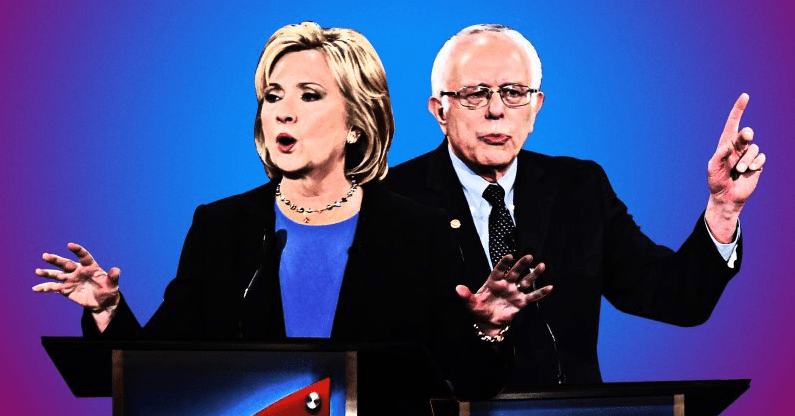Arts Advocate in Chief? Where the Presidential Candidates Stand


With the June 7 primary just around the corner, California voters will soon get to weigh in on who they believe should be the next president of the United States. While issues such as economic inequality and foreign policy have dominated the political discourse, there has been very little discussion about each of the candidate’s arts platform.
The Otis Report on the Creative Economy collects data across artistic fields including arts education, entertainment, digital media, architecture, fashion, and publishing. The most recent report found that the state of California is the leading contributor to the creative economy, with an industry output of $374.5 billion annually. Additionally, there are about 1.6 million creative industry workers in California, making up roughly 10% of the state’s total working population, and Los Angeles remains the creative capital of the U.S. with 18% of its working population in the creative sector.

Leading as one of the state’s most valuable economic assets, the creative industry is to California what the coal industry is to West Virginia. Whether one works directly in the industry, or interacts with it with some regularity, it is important to many Californians that the creative economy continues to thrive underneath the next president.
Whether you’re a young graduate looking to enter the industry, or someone with an already extensive career in the arts, it is important to understand the substantial impact our next president could have on the creative economy.
So which candidate will be the best arts advocate?
Hillary Clinton
Hillary Clinton has quite an extensive history of arts advocacy stretching back to her time as First Lady. In 1997, Clinton gave a statement at The Presidents Committee on the Arts and the Humanities. Clinton highlighted the importance of nurturing creativity as crucial to “the expression of our great democracy.”
In 1999, Clinton created the White House Sculpture Garden and received a National Arts Award for Arts Advocacy for her support of arts education.
As a former Senator from New York, the second largest contributor to the creative economy, Clinton has a history of working closely with arts organizations. In a 2007 statement to the National Dance Education Organization, Clinton praised the value of arts education, citing a study which found “students who studied the arts were more likely to out perform their peers academically.”
Clinton was also a member of the U.S. Senate Cultural Caucus which was formed in 2006 to protect arts education grant programs at the U.S. Department of Education. After completing her tenure as Secretary of State, in 2013 Clinton wrote an op-ed for Vanity Fair in where she discussed art as a tool of diplomacy.
“Artists push boundaries and show what the human spirit is capable of, forming bonds of understanding with people they may never know. For over 50 years, Art in Embassies has showcased the best of this talent. I am grateful, as it promotes creativity, ignites collaboration, and builds on American diplomacy.” – Hillary Clinton
More recently, in April 2016, when asked by a questioner about how she’d advance the arts as president, Clinton responded “The arts are a major reason for urban revitalization… You see it in cities where often times the modern pioneers are the artists.”
Based on her extensive history and continued commitment to supporting the arts, it is clear that Hillary Clinton would be an arts advocate in the White House.
Arts Score: 5
Bernie Sanders
Bernie Sanders also has a strong record of supporting the arts. While Vermont isn’t quite at the level of California and New York in terms of its creative economy, a 2010 study found that Vermont’s art industry outputs about $443.5 million, and the arts industry was the 5th largest employer of Vermont’s working population. It is no surprise then, that Sanders is such a staunch advocate for the arts.
In September 2015, Sanders sent a video to the Arts Action Fund where he expressed his dedication to the arts as a valuable community asset. In 1981, as mayor of Burlington, Vermont, one of Sanders first acts was to create the Burlington Arts Council “hoping to unleash the creativity of [Burlington] residents and harness the untold benefits that investment in the arts brings to communities.”
Sanders continues to highlight his history of defending the arts, and concludes his video with a strong statement where he promises to promote the arts as a major part of his platform.
“You have my promise, that as president, I will be an arts president. I will continue to advocate for robust funding of the arts in our cities, schools, and public spaces. Art is speech. Art is what life is about.” — Bernie Sanders
Sanders also has an excellent Senate voting record in arts advocacy, and has received an A+ on the Arts Actions Fund’s Congressional Arts Report Cards since 2004. Sanders has also been supported by a number of high-profile artists, and has been endorsed by the group Artists and Cultural Leaders for Bernie Sanders.
Sanders strong history of supporting the arts, both as mayor of Burlington and Senator of Vermont, indicate that Sanders would undoubtedly be a “yuge” advocate for the arts in the White House.
Donald Trump
Donald Trump’s record on arts advocacy is far more nebulous than his opponents, due in large part to the fact that he has never held public office. In a March 2016 Washington Post interview, Trump did pay some positive lip service to the value of a well-rounded, liberal arts education.
“I had the great fortune to receive a comprehensive liberal arts education from an Ivy League institution. What is most important is that we examine how one-size-fits-all approaches imposed by the federal government have corrupted the availability and efficacy of liberal arts education. Critical thinking skills, the ability to read, write and do basic math are still the keys to economic success. A holistic education that includes literature and the arts is just as critical to creating good citizens.” — Donald Trump
Trump has personally donated $465,125 to arts-affiliated organization in New York since 1994. However, Trump was at the center of the 1980 Bonwit Teller controversy, where his workmen jackhammered art deco limestone panels into bits despite them being promised to the Metropolitan Museum. When asked why they were destroyed, the Trump organization responded that the historic panels were “without artistic merit.” Not exactly a great example of arts advocacy.
In 1996, Trump weighed in on a controversy surrounding a painting called The Holy Mary Virgin. Trump told the New York Daily News in an statement “It’s not art. It’s absolutely gross, degenerate stuff. It shouldn’t be funded by the government.”
More recently, when questioned by Arts Action Fund members about his position on the arts, Trump responded by describing the aesthetic qualities he would like to incorporate into his Mexican border wall, “I am going to have to add some nice designs to the wall because someday they might name it after me and I want it to look real nice.”
While it is still difficult to determine the extent to which Donald Trump would be an arts advocacy president, his position on the Department of Education alone would have an extremely detrimental impact on arts education and funding.
The creative economy and arts education are important issues to many Californians as they have direct impacts on both our economy and our cultural footprint. Hopefully this will serve as a useful guide to voters as they cast their ballots for our next president and Arts-Advocate-in-Chief.
Arts Score: 1
Photo Credit: Emil Lendof | The Daily Beast
